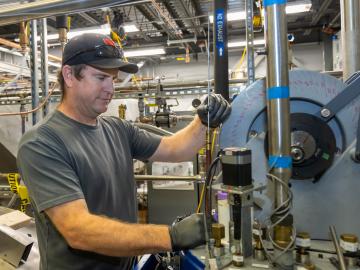Filter News
Area of Research
- Advanced Manufacturing (4)
- Biology and Environment (2)
- Clean Energy (14)
- Fusion and Fission (2)
- Fusion Energy (3)
- Isotopes (10)
- Materials (36)
- Materials for Computing (6)
- National Security (12)
- Neutron Science (3)
- Nuclear Science and Technology (2)
- Quantum information Science (1)
- Supercomputing (4)
- Transportation Systems (1)
News Type
News Topics
- (-) Cybersecurity (9)
- (-) Frontier (3)
- (-) Isotopes (13)
- (-) Materials Science (45)
- (-) National Security (18)
- (-) Physics (21)
- (-) Polymers (13)
- 3-D Printing/Advanced Manufacturing (42)
- Advanced Reactors (15)
- Artificial Intelligence (16)
- Big Data (20)
- Bioenergy (31)
- Biology (37)
- Biomedical (19)
- Biotechnology (6)
- Buildings (27)
- Chemical Sciences (15)
- Clean Water (19)
- Climate Change (35)
- Composites (11)
- Computer Science (51)
- Coronavirus (17)
- Critical Materials (13)
- Decarbonization (22)
- Energy Storage (45)
- Environment (79)
- Exascale Computing (3)
- Fusion (16)
- Grid (27)
- High-Performance Computing (19)
- Hydropower (8)
- Irradiation (2)
- ITER (4)
- Machine Learning (14)
- Materials (42)
- Mathematics (4)
- Mercury (7)
- Microscopy (20)
- Molten Salt (5)
- Nanotechnology (18)
- Net Zero (3)
- Neutron Science (35)
- Nuclear Energy (32)
- Partnerships (1)
- Quantum Computing (5)
- Quantum Science (12)
- Security (7)
- Simulation (10)
- Space Exploration (10)
- Statistics (1)
- Summit (8)
- Sustainable Energy (57)
- Transportation (47)
Media Contacts

Associate Technician Sean Hollander is the keeper of the Fundamental Neutron Physics Beamline, which is operated by the Physics Division at the Spallation Neutron Source at ORNL, where scientists use neutrons to study all manner of matter.

ORNL scientists develop a sample holder that tumbles powdered photochemical materials within a neutron beamline — exposing more of the material to light for increased photo-activation and better photochemistry data capture.

ORNL researchers used electron-beam additive manufacturing to 3D-print the first complex, defect-free tungsten parts with complex geometries.

Mohamad Zineddin hopes to establish an interdisciplinary center of excellence for nuclear security at ORNL, combining critical infrastructure assessment and protection, risk mitigation, leadership in nuclear security, education and training, nuclear security culture and resilience strategies and techniques.

ORNL’s Assaf Anyamba has spent his career using satellite images to determine where extreme weather may lead to vector-borne disease outbreaks. His work has helped the U.S. government better prepare for outbreaks that happen during periods of extended weather events such as El Niño and La Niña, climate patterns in the Pacific Ocean that can affect weather worldwide.

Chelsea Chen, a polymer physicist at ORNL, is studying ion transport in solid electrolytes that could help electric vehicle battery charges last longer.



Raina Setzer knows the work she does matters. That’s because she’s already seen it from the other side. Setzer, a radiochemical processing technician in Oak Ridge National Laboratory’s Isotope Processing and Manufacturing Division, joined the lab in June 2023.

Walters is working with a team of geographers, linguists, economists, data scientists and software engineers to apply cultural knowledge and patterns to open-source data in an effort to document and report patterns of human movement through previously unstudied spaces.




